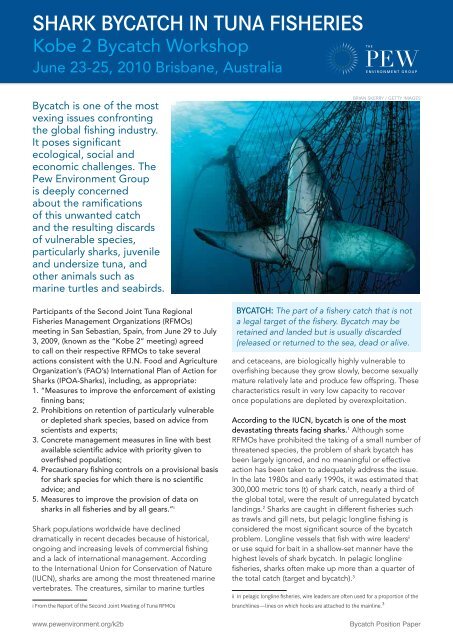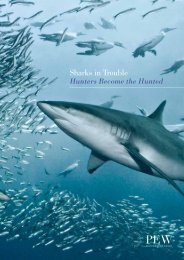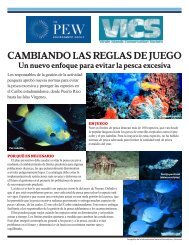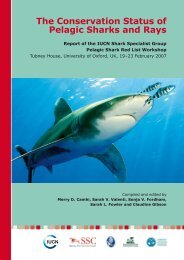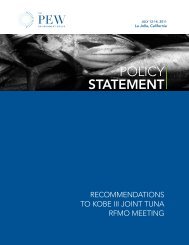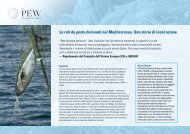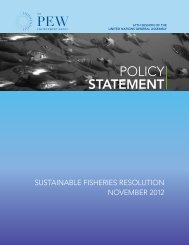SHARK BYCATCH IN TUNA FISHERIES
SHARK BYCATCH IN TUNA FISHERIES
SHARK BYCATCH IN TUNA FISHERIES
You also want an ePaper? Increase the reach of your titles
YUMPU automatically turns print PDFs into web optimized ePapers that Google loves.
<strong>SHARK</strong> <strong>BYCATCH</strong> <strong>IN</strong> <strong>TUNA</strong> <strong>FISHERIES</strong><br />
Kobe 2 Bycatch Workshop<br />
June 23-25, 2010 Brisbane, Australia<br />
Bycatch is one of the most<br />
vexing issues confronting<br />
the global fishing industry.<br />
It poses significant<br />
ecological, social and<br />
economic challenges. The<br />
Pew Environment Group<br />
is deeply concerned<br />
about the ramifications<br />
of this unwanted catch<br />
and the resulting discards<br />
of vulnerable species,<br />
particularly sharks, juvenile<br />
and undersize tuna, and<br />
other animals such as<br />
marine turtles and seabirds.<br />
BRIAN SKERRY / getty images<br />
Participants of the Second Joint Tuna Regional<br />
Fisheries Management Organizations (RFMOs)<br />
meeting in San Sebastian, Spain, from June 29 to July<br />
3, 2009, (known as the “Kobe 2” meeting) agreed<br />
to call on their respective RFMOs to take several<br />
actions consistent with the U.N. Food and Agriculture<br />
Organization’s (FAO’s) International Plan of Action for<br />
Sharks (IPOA-Sharks), including, as appropriate:<br />
1. “Measures to improve the enforcement of existing<br />
finning bans;<br />
2. Prohibitions on retention of particularly vulnerable<br />
or depleted shark species, based on advice from<br />
scientists and experts;<br />
3. Concrete management measures in line with best<br />
available scientific advice with priority given to<br />
overfished populations;<br />
4. Precautionary fishing controls on a provisional basis<br />
for shark species for which there is no scientific<br />
advice; and<br />
5. Measures to improve the provision of data on<br />
sharks in all fisheries and by all gears.” i<br />
Shark populations worldwide have declined<br />
dramatically in recent decades because of historical,<br />
ongoing and increasing levels of commercial fishing<br />
and a lack of international management. According<br />
to the International Union for Conservation of Nature<br />
(IUCN), sharks are among the most threatened marine<br />
vertebrates. The creatures, similar to marine turtles<br />
i From the Report of the Second Joint Meeting of Tuna RFMOs<br />
<strong>BYCATCH</strong>: The part of a fishery catch that is not<br />
a legal target of the fishery. Bycatch may be<br />
retained and landed but is usually discarded<br />
(released or returned to the sea, dead or alive.<br />
and cetaceans, are biologically highly vulnerable to<br />
overfishing because they grow slowly, become sexually<br />
mature relatively late and produce few offspring. These<br />
characteristics result in very low capacity to recover<br />
once populations are depleted by overexploitation.<br />
According to the IUCN, bycatch is one of the most<br />
devastating threats facing sharks. 1 Although some<br />
RFMOs have prohibited the taking of a small number of<br />
threatened species, the problem of shark bycatch has<br />
been largely ignored, and no meaningful or effective<br />
action has been taken to adequately address the issue.<br />
In the late 1980s and early 1990s, it was estimated that<br />
300,000 metric tons (t) of shark catch, nearly a third of<br />
the global total, were the result of unregulated bycatch<br />
landings. 2 Sharks are caught in different fisheries such<br />
as trawls and gill nets, but pelagic longline fishing is<br />
considered the most significant source of the bycatch<br />
problem. Longline vessels that fish with wire leaders ii<br />
or use squid for bait in a shallow-set manner have the<br />
highest levels of shark bycatch. In pelagic longline<br />
fisheries, sharks often make up more than a quarter of<br />
the total catch (target and bycatch). 3<br />
ii In pelagic longline fisheries, wire leaders are often used for a proportion of the<br />
branchlines—lines on which hooks are attached to the mainline. 3<br />
www.pewenvironment.org/k2b<br />
Bycatch Position Paper
Discard mortality presents another very serious<br />
problem: Recent research on blue sharks estimated an<br />
annual average of more than 20,000 t of dead discards<br />
in the North Atlantic solely from pelagic longline<br />
fisheries, a number equal to the nominal catch reported<br />
to the International Commission for the Conservation<br />
of Atlantic Tunas by these fisheries. 4<br />
Sound, precautionary management of bycatch species<br />
is required to prevent population collapse, allow<br />
species recovery and maintain ecosystem function. It<br />
is vital that the tuna RFMOs take meaningful action<br />
to address this issue. However, current understanding<br />
of the impact of bycatch is profoundly inadequate<br />
because catch statistics are scarce and rarely include<br />
discards. This undermines effective conservation<br />
and management of high seas fisheries, particularly<br />
shark species. Shark catches are often unreported,<br />
underreported or recorded in generic species<br />
categories, contrary to Article 5(j) of the U.N. Fish<br />
Stocks Agreement (UNFSA). iii In essence, shark fishing<br />
on the high seas is illegal, unreported and unregulated.<br />
It is estimated that actual shark landings are three to<br />
four times higher than the catches reported to the<br />
FAO. 5 In 2007, only 20 percent of those shark-catch<br />
data were provided at species level. 6 As a result, the<br />
status and stock assessments of individual shark species<br />
are very difficult to determine.<br />
The Kobe 2 Bycatch Workshop provides a timely<br />
opportunity to improve the management of tuna<br />
fisheries on a global scale. The Pew Environment<br />
Group calls on participants to agree to concrete actions<br />
to minimize bycatch and discards and their impact<br />
on vulnerable species, and particularly to stop the<br />
overfishing of sharks by agreeing to strong actions<br />
that will address current problems on the high seas.<br />
iii Article 5(j): “[C]oastal States and States fishing on the high seas shall … collect and share,<br />
in a timely manner, complete and accurate data concerning fishing activities on, inter alia,<br />
vessel position, catch of target and non-target species and fishing effort, as set out in Annex<br />
I, as well as information from national and international research programmes.”<br />
RECOMMENDATIONS<br />
Accurately assess bycatch and discards.<br />
• RFMOs should adopt “No Data—No Fishing”<br />
requirements, so that any member nation failing to<br />
provide credible required information/data should<br />
be prohibited from fishing, particularly with regard to<br />
sharks.<br />
• In addition to reporting species-specific data on<br />
catches, effort by gear type, landings and trade,<br />
member states should report complete bycatch and<br />
discard (both dead and alive) information at the<br />
species level, particularly for all shark species.<br />
Immediately adopt precautionary management<br />
measures.<br />
• No retention of species at risk: When conservation<br />
and management plans are not in place, retention<br />
should be prohibited for species at risk, including<br />
target species and bycatch such as sharks.<br />
Additionally, RFMOs should agree to prohibit<br />
retention of any species listed in Appendix I of the<br />
Convention on International Trade in Endangered<br />
Species of Wild Fauna and Flora (CITES) or on the<br />
IUCN Red List of Threatened Species as Critically<br />
Endangered, Endangered or Vulnerable (the<br />
“Threatened” category).<br />
• Implement precautionary management measures:<br />
RFMOs should fully implement the precautionary<br />
approach by requiring and heeding advice from<br />
their scientific committees to include “limit” and<br />
“target” reference points that ultimately include<br />
dead discards for all species, including non-target<br />
species, especially shark species. When this advice is<br />
not available, no fishing should take place.<br />
• Adopt a “fins naturally attached” policy: In line<br />
with the Kobe 2 recommendation on improving the<br />
enforcement of finning bans, all tuna RFMOs should<br />
adopt “fins naturally attached” policies, because<br />
this method prevents circumvention of the law and<br />
photolibrary.com<br />
www.pewenvironment.org/k2b<br />
Bycatch Position Paper
provides the optimum conditions for monitoring and<br />
enforcement.<br />
• Implement marine protected areas (MPAs) and<br />
time-area closures: RFMOs should implement MPAs<br />
and time-area closures for fisheries management<br />
purposes in accordance with the best available<br />
scientific advice to protect ecologically or<br />
biologically significant areas, particularly to shark<br />
species.<br />
• Develop national plans of action for the<br />
conservation and management of sharks (NPOA-<br />
Shark): Consistent with FAO’s IPOA-Sharks, States<br />
should develop an NPOA-Shark if their vessels<br />
conduct directed fisheries for sharks or if their vessels<br />
routinely catch sharks in non-directed fisheries.<br />
Immediately implement bycatch mitigation<br />
methods<br />
• Mandatory gear modifications on pelagic longlines.<br />
o Ban on wire leader: Wire leaders are typically<br />
used in pelagic longline fisheries to maximize<br />
shark retention. 3 Use of this gear creates a de<br />
facto targeted fishery for sharks. In fisheries<br />
where a large proportion of caught sharks are<br />
killed either for retention or discarding, a ban on<br />
wire leaders would probably reduce shark fishing<br />
mortality because sharks would be more likely to<br />
escape before being hauled in.<br />
o Circle hooks: For marine turtles, tuna and several<br />
billfish and shark species, the use of circle hooks<br />
has been associated with lower rates of deephooking<br />
and subsequent serious injury, hence<br />
increasing post-release survival rates. Estimates<br />
suggest that several target and common bycatch<br />
species are two to five times more likely to survive<br />
capture on circle hooks than on J hooks. 7<br />
o Fish bait: Experimental trials and interviews with<br />
fishermen confirmed that using fish instead of<br />
squid as bait results in a significant decrease<br />
in shark catch rates (on the order of 30 to 40<br />
percent), particularly of blue sharks. 3<br />
• Mandatory gear modifications in other fisheries.<br />
o Turtle excluder devices (TED) in trawl fisheries:<br />
TEDs are a very effective gear modification to<br />
mitigate marine turtle bycatch that can also<br />
substantially reduce (by more than 85 percent) the<br />
numbers of large sharks and rays (longer than 1<br />
meter) caught. 8<br />
Establish greater cooperation across tuna RFMOs.<br />
• Undertake research: Member nations should<br />
expeditiously undertake fishing trials to determine<br />
the feasibility and effectiveness of appropriate<br />
combinations of other gear specifications, fishing<br />
practices and measures in reducing the bycatch,<br />
injury and mortality of sharks. Assessments should<br />
be conducted on the effects on the catch of<br />
target species, especially juvenile tunas and other<br />
bycatch species, and results shared with all RFMOs.<br />
Specifically research should focus on:<br />
o Shark deterrents—including magnetic,<br />
electropositive rare earth metals and electrical<br />
deterrents—that hold promise but require<br />
significantly more investigation and large-scale<br />
trials.<br />
o Other fishing methods, such as gill nets and<br />
trawls, tend to have high shark capture mortality;<br />
new gear designs such as increasing the gill net’s<br />
tension, bycatch reduction devices and spatial and<br />
temporal management should be further tested as<br />
effective and commercially viable shark avoidance<br />
methods.<br />
• Establish a joint RFMOs bycatch task force: To<br />
ensure greater cooperation, coordinated data<br />
sharing and collection among RFMOs, a joint<br />
task force focused on key bycatch species should<br />
be convened annually. This would assist with<br />
harmonizing the conservation and management<br />
measures and sharing research advances in a timely<br />
manner by each of the five tuna RFMOs.<br />
For more information: Matt Rand, Director, Global<br />
Shark Conservation, Pew Environment Group<br />
mrand@pewtrusts.org<br />
REFERENCES<br />
1 M.D. Camhi et al., The Conservation Status of Pelagic Sharks and Rays:<br />
Report of the IUCN Shark Specialist Group Pelagic Shark Red List Workshop,<br />
IUCN Species Survival Commission Shark Specialist Group (2007),<br />
http://cmsdata.iucn.org/downloads/ssg_pelagic_report_final.pdf.<br />
2 R. Bonfil, “World bycatches of sharks in high-seas fisheries: Appraising<br />
the waste of a resource,” In: Bycatch in Fisheries and Their Impact on the<br />
Ecosystems (Fisheries Center, University of British Columbia, Vancouver,<br />
2(1): 41-4 (1995).<br />
3 E. Gilman et al., Shark depredation and unwanted bycatch in pelagic<br />
longline fisheries: Industry practices and attitudes, and shark avoidance<br />
strategies, Western Pacific Regional Fishery Management Council (2007),<br />
www.wpcouncil.org/pelagic/Documents/Shark-Longline_Interactions_<br />
Report.pdf.<br />
4 S.E. Campana et al., “Bycatch and discard mortality in commercially<br />
caught blue sharks Prionace glauca assessed using archival satellite<br />
pop-up tags,” Marine Ecology Progress Series 387: 241-53 (2009), www.<br />
int-res.com/abstracts/meps/v387/p241-253/.<br />
5 S.C. Clarke et al., “Global estimates of shark catches using trade<br />
records from commercial markets,” Ecology Letter 9(10): 1115-26 (2006),<br />
www.ncbi.nlm.nih.gov/pubmed/16972875.<br />
6 M. Lack and G. Sant, Trends in Global Shark Catch and Recent<br />
Developments in Management, TRAFFIC International (2009), www.<br />
traffic.org/fish.<br />
7 E.H. Carruthers et al., “Estimating the odds of survival and identifying<br />
mitigation opportunities for common bycatch in pelagic longline<br />
fisheries,” Biological Conservation 142(11): 2620-30 (November 2009),<br />
http://discover-decouvrir.cisti-icist.nrc-cnrc.gc.ca/dcvr/ctrl?action=shwart<br />
&aix=0&aid=12247712.<br />
8 D. Brewer et al., “The impact of turtle excluder devices and bycatch<br />
reduction devices on diverse tropical marine communities in Australia’s<br />
northern prawn trawl fishery,” Fisheries Research 81: 176-88 (2006),<br />
www.sciencedirect.com/science?_ob=ArticleURL&_udi=B6T6N-<br />
4KN5JSY-2&_user=10&_coverDate=11%2F30%2F2006&_rdoc=1&_<br />
fmt=high&_orig=search&_sort=d&_docanchor=&view=c&_<br />
acct=C000050221&_version=1&_urlVersion=0&_userid=10&md5=bba0<br />
ccbaef42e72a9295baa092f8661b.<br />
www.pewenvironment.org/k2b<br />
Bycatch Position Paper


